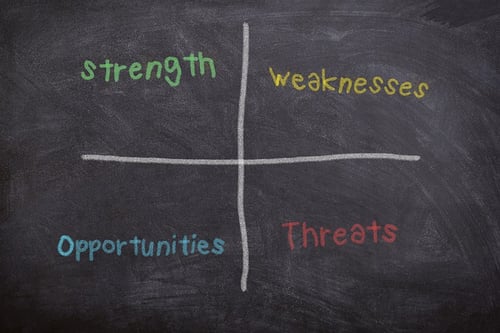Index Content
Before we start explaining how to do the SWOT and SWOT analysis, you should know that the SWOT analysis is the next step you should do when you have finished the SWOT analysis, because even if you think that with all the information gathered from the internal and external aspects you have everything you need, the SWOT analysis allows you to strengthen those elements obtained in the SWOT matrix.
SWOT Analysis
The SWOT analysis, also known as SWOT analysis, is a technique used by companies to know their internal situation (weaknesses and strengths) and external situation (threats and opportunities). The objective of this is to know the real situation in order to obtain an advantage over competitors.
Internal analysis
- Strengths: For the internal analysis it is necessary to consider the positive factors that an organisation has to generate a great advantage over its competitors.
- Weaknesses: With the elements, energy resources, skills and attitudes of an organisation, it is possible to determine the barriers it has to achieve positive results. This can also include elements related to finance, market, organisation and control. After identifying the weaknesses of the organisation, it is necessary to carry out a strategy to immediately eliminate the internal problems.

External analysis
- Opportunities are a series of positive and favourable factors for the organisation. It is important to know what they are in order to take advantage of them and provide positive factors for the brand. In this section, several factors should be taken into account:
- Circumstances that can improve the organisation's situation
- market opportunities that may prove to be beneficial
- technology-related developments in the market.
- Changes in legal/policy regulations
- Strengths. Negative situations linked to the project that may harm its operation. To solve this circumstance, it is essential to design an appropriate strategy. To do so, as brand manager or strategy manager, you must keep in mind some concepts, such as:
- Obstacles faced by the company.
- The actions and campaigns being developed by the competition.
- The possible existence of budget problems
- The performance and engagement of market rivals.
how to do a good SWOT analysis?
- Strategy building: To execute this analysis in your organisation, you first need to make a plan. You need to recognise the external and internal characteristics and factors of your organisation.
- Matching and conversion: This second step consists of finding the competitive advantage over competitors by bringing together the organisation's strengths and opportunities. It is also possible to convert weaknesses or threats into opportunities and strengths in order to take advantage of them in the market .
- Finally, marketing managers in organisations should use the SWOT analysis to study the strengths and weaknesses of the competition, studying a multitude of factors: cost structure of each competitor, sources of profit, resources, competitive positioning and product differentiation, among others.

CAME analysis
The SWOT analysis is a complementary tool to the SWOT analysis that is used to make better use of the conclusions drawn in this analysis. The objective is to determine the strategy in a clearer way. To do this, different aspects that are obtained in the SWOT analysis are taken as a basis. The meaning of the acronyms of this tool is broken down as follows: correct, confront, maintain and exploit.
what are the strategies for a good SWOT analysis?
When you are considering a SWOT and SWOT analysis, you should always have your eye on future strategies. The types of strategies you can apply are some of the following:
- Offensive: This strategy, also known as attack and market positioning, works on exploiting the strengths of your business and takes advantage of the opportunities offered by the market. They are an opportunity for SMEs and start-ups that offer great competitiveness. Thanks to their flexibility in processes and structure, they can take advantage of the opportunities offered by the sector.
- Survival: The survival strategy arises when the company does not recognise the threats that have arisen in the market, usually because young people start working with new ideas and greater flexibility, which is a great success considering the high level of competition.
- Defensive: Defensive strategies are those that must be used by consolidated businesses that have great strength factors and need to face competitors. The main objective is to work on all the strengths or competitive advantages of the business in order to be able to face the threats that arise in the market.
- Reorientation: Finally, the reorientation strategy is used to change the path that the company is following. Sometimes it even happens that the business model is radically changed as a last chance to survive in such a competitive market. The objective of this method is to redirect the company towards another objective in order to take advantage of the new opportunities offered by the market.
As you have seen, SWOT and CAME analyses are two elements that all companies must take into account in Inbound Marketing in order to improve their business and face competitors.





